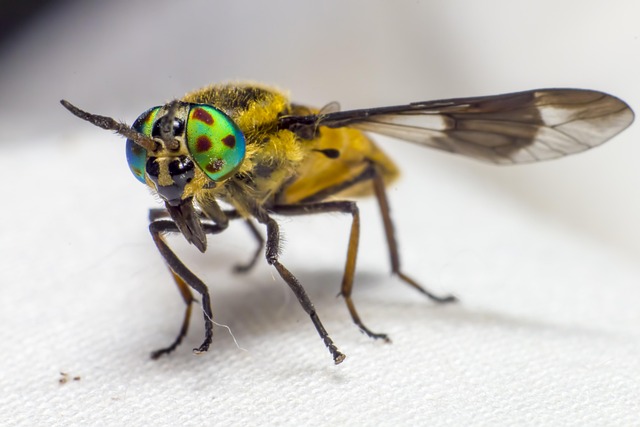Understanding the behavior and nesting habits of stinging insects like bees, wasps, and hornets is crucial for safe and effective stinging insect extermination. These pests, though beneficial to ecosystems, can cause severe pain and allergic reactions. Professional exterminators use specialized knowledge and tools to navigate nest locations, employ targeted treatments, and minimize environmental disruption. Swift action is vital to maintain a safe living environment. Proactive measures include regular property inspections, maintaining cleanliness, educating others, installing screens, and immediately contacting professionals for infestations or urgent issues.
“In many homes, a sudden encounter with stinging pests can cause panic, especially during urgent situations. This article explores efficient fast-response services tailored for immediate relief from these pesky intruders. From understanding their behavior and impact to identifying common habitats, we delve into rapid extermination techniques that offer lasting solutions. Additionally, discover practical prevention strategies to safeguard your space. Get equipped with knowledge on stinging insect extermination and reclaim your comfort.”
Understanding Stinging Insect Behavior and Their Impact
Understanding the behavior of stinging insects is crucial when it comes to addressing urgent issues. These pests, such as bees, wasps, and hornets, play a vital role in ecosystem balance but can pose significant risks when their nests are disturbed or their territories threatened. In response to perceived threats, they defend their colonies aggressively, often resulting in stings that can cause severe pain and, in some cases, life-threatening allergic reactions.
When a stinging insect extermination service is required, it’s essential to recognize the impact of these insects beyond mere annoyance. Their rapid response to stimuli means that addressing an issue promptly is critical. Professional exterminators are equipped with specialized knowledge and tools to navigate the intricate labyrinthine of nest locations and employ effective strategies for extermination while minimizing disruption to the surrounding environment and non-target species.
Common Stinging Pests and Their Habitats
Stinging pests, such as bees, wasps, and hornets, are a common nuisance, especially during warmer months. These insects play a vital role in our ecosystem by pollinating plants and maintaining biodiversity. However, when their nests are located near human habitats or within homes, they can pose significant risks, particularly to individuals with allergies. Understanding the habits of these pests is crucial for effective stinging insect extermination.
Bees typically build nests in protected areas like trees, bushes, or even attics and walls. Wasps, on the other hand, prefer to nest near human structures, often in hollows, under roof overhangs, or in gardens. Hornets are known to construct large paper-like nests, usually hanging from branches or fixed objects. Identifying their habitats is essential for targeted stinging insect extermination, ensuring a safe and effective resolution to these pest issues.
Rapid Response Extermination Techniques
In the event of a stinging pest invasion, swift action is crucial to maintain a safe and comfortable living environment. Rapid response extermination techniques are designed to address these urgent issues efficiently. Professional pest control services employ specialized equipment and knowledge to handle high-pressure situations, ensuring swift and effective elimination of stinging insects like bees, wasps, and hornets.
These techniques include targeted treatments using modern insecticides that minimize environmental impact while swiftly neutralizing the threat. Trained technicians also implement strategies such as sealing entry points, removing nests, and implementing preventative measures to stop future infestations. This multi-pronged approach combines immediate relief with long-term solutions for stinging insect extermination.
Effective Prevention Strategies for Future Incidents
To prevent future incidents with stinging insects, it’s crucial to implement a multi-faceted strategy that includes both proactive measures and swift action. Regular inspections are key; identifying potential nesting sites around your property can help in eliminating them before they become issues. Keeping your home and surroundings clean is also essential—stowing away food securely, trimming vegetation, and sealing entry points can significantly reduce the likelihood of attracting these pests.
Additionally, educating your family and guests about stinging insects and their behavior can foster awareness. Installing screens on windows and doors ensures that these insects cannot easily access indoor spaces. In case of an infestation or urgent issue, immediate contact with professional stinging insect extermination services is vital to resolve the problem swiftly and effectively, preventing further disturbances.
In addressing urgent stinging pest issues, swift action is key to minimizing impact and preventing future incidents. Understanding these insects’ behavior, identifying common habitats, and employing rapid response techniques empower both professionals and homeowners alike to effectively manage and eradicate these nuisances. By implementing robust prevention strategies, we can significantly reduce the likelihood of sting-related incidents, ensuring safer living environments. For swift and reliable stinging insect extermination, professional services equipped with modern methods are indispensable.
